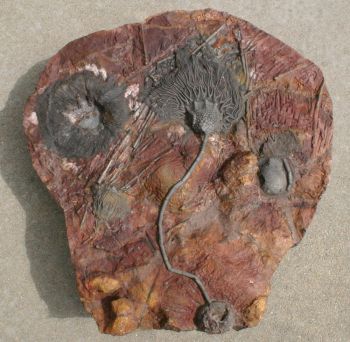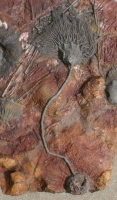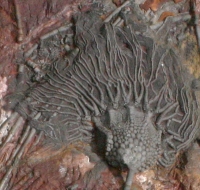
Crinoids, commonly referred to as sea lilies, are ocean dwelling creatures that typically live their lives attached to the sea floor or attached to an object that is floating on the surface of the water. They are composed of three main body parts: the arms that filter food particles out of the water which are attached to the head (or calyx) which houses the internal organs and mouth parts, the stem, and the root system called a hold fast, which attaches to the sea floor. Scyphocrinites elegans was different. It was a camerate crinoid which refers to the bulbous structure which is believed to be a float. This bulb or float would have allowed it to live a palagic (ocean dwelling) life and would account for its widespread distribution. It was a free-floating crinoid which hung upside down from a float at the surface of the water. They are typically never found with the float attached. They would normally break off somewhere along the stem and fall to the bottom. The float would then break down, probably due to lack of nourishment, and fall to the bottom as well. Crinoids are animals despite their plant-like appearance. They are members of a phylum of sea creatures known as Echinodermata, which means "spiny skin." Other examples of non-extinct echinoderms include sea urchins, sand dollars, sea cucumbers, and starfish.
Scyphocrinites elegans is from the Devonian, 395-360 million years ago. The Devonian is known as "The Age of Fishes." Crinoids became more widespread during the Mississippian Age, approximately 347-325 million years ago. The Mississippian Age is when crinoids reached their peak, carpeting the floors of the shallow seas. The Mississippian Age has been called "The Age of Crinoids." The fossil record includes about 2100 species of crinoids and 800 species survive today. Modern day crinoids live at great depths in the ocean. Because crinoids disarticulate easily when they die, we usually only find parts of them (usually stems). Complete crinoids are a rare and treasured find.
This specimen of Scyphocrinites elegans is nicely contrasted in grey to black against the red colored matrix.
high-density poly-urethane
26.5 x 25 x 2.25 inches
Item 3454
Category: Replicas
Type: Skeletons
Phylum: Invertebrates
Class: Crinoids
MORE PHOTOS:




Now Over 1,000 Items!
PrehistoricStore.com offers the largest selection of replica fossils and other fossil-related products anywhere in the world!
Download a Full Catalog (3MB PDF)
OVER 260 PAGES OF REPLICAS AND MORE!
